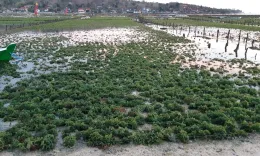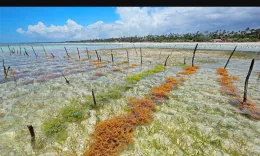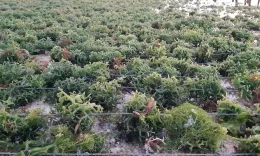Recent News

Farmers struggle amid declining seaweed exports
Despite increasing national seaweed production, Indonesian seaweed farmers have been struggling to market their product, particularly in the wake of a significant drop in demand from overseas markets over the past several months. Speaking to reporters recently on the sidelines of a discussion in Makassar, South Sulawesi, Indonesia Seaweed Industry Association secretary Arman Arfah said the significant decline in overseas demand for Indonesian seaweed had started since earlier this year after China, the main export destination for Indonesian seaweed, ceased imports, having stockpiled a huge volume of the commodity.
The government must build warehouses in seaweed production centers to store the surplus,' Arman said. Indonesia is the world's biggest producer of seaweed, especially the gracillaria variety; last year, the country produced 10.2 million tons of seaweed, with some 30 percent exported to foreign markets. The domestic market, however, could only absorb 40 percent of national seaweed production, leaving the remaining 30 percent unabsorbed.
To store the unabsorbed production, and to anticipate future harvest failures, Arman said the government needed to build at least 30 seaweed storage facilities across the archipelago, each with the capacity to store 500 tons of seaweed. The price of standard-quality seaweed currently stands at between Rp 3,000 (25 US cents) and Rp 3,500 per kilogram, a sharp drop from Rp 9,000 per kg earlier this year. High-quality seaweed, meanwhile, is now priced at around Rp 6,000 per kg.
Seaweed farmer Bakhtiar, 48, from Wajo regency, South Sulawesi, said that demand for and the price of seaweed had dropped since June this year. Bakhtiar, who owns a 3.5-hectare seaweed farm, said seaweed buyers had stopped coming to buy local farmers' yield, forcing producers to market the commodity themselves.
When the seaweed price is normal, traders come to farmers. But since several months ago, farmers have to go to the traders,' he said. South Sulawesi is one of the biggest seaweed production centers in the country, especially of the gracillaria variety. National production of gracillaria seaweed reaches up to 1 million tons annually, with some 800,000 tons coming from South Sulawesi.
Gracillaria seaweed is mostly exported to China, with the domestic industry only absorbing a small volume, because seaweed processing plants are only available in Java. The domestic seaweed industry tends only to use the eucheuma cottonii and spinosum varieties. The general director for aquaculture at the Maritime Affairs and Fisheries Ministry, Slamet Soebijakto, meanwhile said the government and local seaweed industry should work together to open new markets for the commodity.
We have made efforts to open new markets, such as Chile and the Philippines. The Chinese market is opening up again too, but we also hope the domestic industry will grow and increase utilization,' he said.
This article was published in thejakartapost.com with the title "Farmers struggle amid declining seaweed exports"...
The government must build warehouses in seaweed production centers to store the surplus,' Arman said. Indonesia is the world's biggest producer of seaweed, especially the gracillaria variety; last year, the country produced 10.2 million tons of seaweed, with some 30 percent exported to foreign markets. The domestic market, however, could only absorb 40 percent of national seaweed production, leaving the remaining 30 percent unabsorbed.
To store the unabsorbed production, and to anticipate future harvest failures, Arman said the government needed to build at least 30 seaweed storage facilities across the archipelago, each with the capacity to store 500 tons of seaweed. The price of standard-quality seaweed currently stands at between Rp 3,000 (25 US cents) and Rp 3,500 per kilogram, a sharp drop from Rp 9,000 per kg earlier this year. High-quality seaweed, meanwhile, is now priced at around Rp 6,000 per kg.
Seaweed farmer Bakhtiar, 48, from Wajo regency, South Sulawesi, said that demand for and the price of seaweed had dropped since June this year. Bakhtiar, who owns a 3.5-hectare seaweed farm, said seaweed buyers had stopped coming to buy local farmers' yield, forcing producers to market the commodity themselves.
When the seaweed price is normal, traders come to farmers. But since several months ago, farmers have to go to the traders,' he said. South Sulawesi is one of the biggest seaweed production centers in the country, especially of the gracillaria variety. National production of gracillaria seaweed reaches up to 1 million tons annually, with some 800,000 tons coming from South Sulawesi.
Gracillaria seaweed is mostly exported to China, with the domestic industry only absorbing a small volume, because seaweed processing plants are only available in Java. The domestic seaweed industry tends only to use the eucheuma cottonii and spinosum varieties. The general director for aquaculture at the Maritime Affairs and Fisheries Ministry, Slamet Soebijakto, meanwhile said the government and local seaweed industry should work together to open new markets for the commodity.
We have made efforts to open new markets, such as Chile and the Philippines. The Chinese market is opening up again too, but we also hope the domestic industry will grow and increase utilization,' he said.
This article was published in thejakartapost.com with the title "Farmers struggle amid declining seaweed exports"...
16/03/2021

Indonesia continues to export dried seaweed to South Korea despite COVID-19
JAKARTA. Indonesia continued to export dried seaweed to South Korea (South Korea) with an export value of US$ 17,000 amid the coronavirus (COVID-19) pandemic,
Agus Suparmanto, Minister of Trade, said the export was a continuation of Indonesia's trade mission in Busan, South Korea in November 2019. "This is also in line with the high demand for food products despite COVID-19 pandemic," Suparmanto explained through an official statement.
According to the contract, CV Sarana Multi Jaya acts as an exporter. The products departed from Samarinda Harbor at the end of March 2020, and arrived in Busan on 18 April.
If seaweed products exported to Busan are in line with the buyer's expectations, the company will ship the next shipment.
Meanwhile, the Ministry of Trade admitted that importers from South Korea were not worried about the COVID-19 pandemic in Indonesia. However, the ministry will continue to monitor food products exported to South Korea. (KR/AR)
Source : https://www.idnfinancials.com/news/33878/indonesia-continues-export-dried-seaweed-south-korea-covid..
Agus Suparmanto, Minister of Trade, said the export was a continuation of Indonesia's trade mission in Busan, South Korea in November 2019. "This is also in line with the high demand for food products despite COVID-19 pandemic," Suparmanto explained through an official statement.
According to the contract, CV Sarana Multi Jaya acts as an exporter. The products departed from Samarinda Harbor at the end of March 2020, and arrived in Busan on 18 April.
If seaweed products exported to Busan are in line with the buyer's expectations, the company will ship the next shipment.
Meanwhile, the Ministry of Trade admitted that importers from South Korea were not worried about the COVID-19 pandemic in Indonesia. However, the ministry will continue to monitor food products exported to South Korea. (KR/AR)
Source : https://www.idnfinancials.com/news/33878/indonesia-continues-export-dried-seaweed-south-korea-covid..
16/03/2021

Not Disturbed by Covid-19, Batam Exports 53 Tons of Dried Seaweed to China
TRIBUNBATAM.id - In the midst of Corona virus outbreak, Minister of Maritime and Fisheries Edhy Prabowo released 53 tons of dried seaweed exports from Batam, Riau Islands to China.
The export release of more than IDR 159 million had no problems, even though Corona virus or Covid-19 was engulfing several regions in this Bamboo Curtain country.
"Alhamdulillah, there is no difficulty and exports continue to run, despite the tumultuous outbreak of this deadly virus," Edhy said during the release of exports in Batam Air Bay, Wednesday (3/4/2020).
In one month, the company can produce 200 tons of dried seaweed.
Wahyudi's company is also active in sending seaweed to China, Vietnam and Singapore.
In fact, throughout 2019, total exports reached 1,371 tons with value of IDR 4.48 billion.
Meanwhile, this time were exports for the third time during February 2020 and all were sent to China.
"I appreciate the steps taken by BKIPM Batam to take the ball to business players, so the process of exporting dried seaweed is made easier.
Regarding the land constraints, I will coordinate with Regional Government and other ministries to find solution," said Edhy.
Artikel ini telah tayang di TribunBatam.id dengan judul Not Disturbed by Covid-19, Batam Exports 53 Tons of Dried Seaweed to China, https://batam.tribunnews.com/2020/03/08/not-disturbed-by-covid-19-batam-exports-53-tons-of-dried-seaweed-to-china.
Penulis:
Editor:
..
The export release of more than IDR 159 million had no problems, even though Corona virus or Covid-19 was engulfing several regions in this Bamboo Curtain country.
"Alhamdulillah, there is no difficulty and exports continue to run, despite the tumultuous outbreak of this deadly virus," Edhy said during the release of exports in Batam Air Bay, Wednesday (3/4/2020).
In one month, the company can produce 200 tons of dried seaweed.
Wahyudi's company is also active in sending seaweed to China, Vietnam and Singapore.
In fact, throughout 2019, total exports reached 1,371 tons with value of IDR 4.48 billion.
Meanwhile, this time were exports for the third time during February 2020 and all were sent to China.
"I appreciate the steps taken by BKIPM Batam to take the ball to business players, so the process of exporting dried seaweed is made easier.
Regarding the land constraints, I will coordinate with Regional Government and other ministries to find solution," said Edhy.
Artikel ini telah tayang di TribunBatam.id dengan judul Not Disturbed by Covid-19, Batam Exports 53 Tons of Dried Seaweed to China, https://batam.tribunnews.com/2020/03/08/not-disturbed-by-covid-19-batam-exports-53-tons-of-dried-seaweed-to-china.
Penulis:
Editor:
..
16/03/2021

